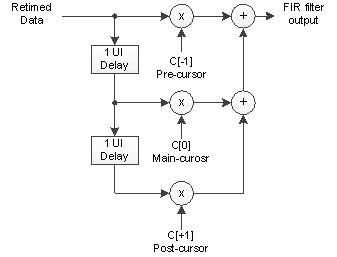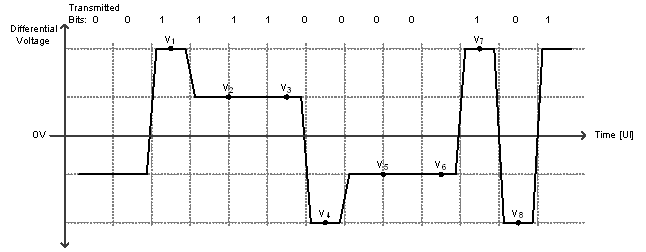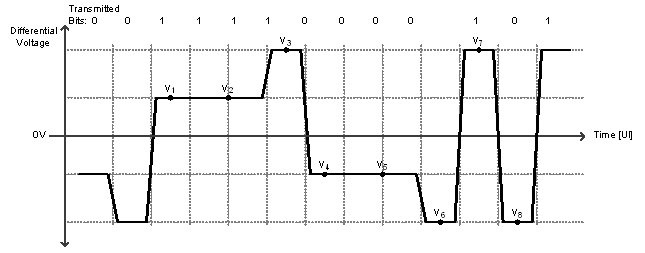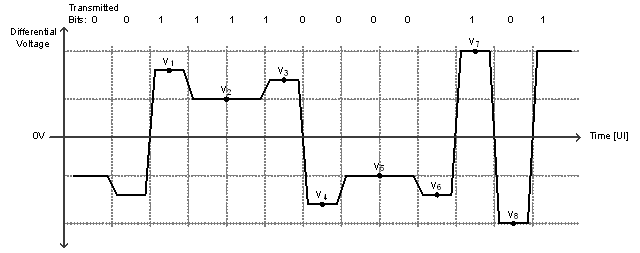ZHCSKE7B February 2017 – October 2019 DS250DF210
PRODUCTION DATA.
- 1 特性
- 2 应用
- 3 说明
- 4 修订历史记录
- 5 说明 (续)
- 6 Pin Configuration and Functions
-
7 Specifications
- 7.1 Absolute Maximum Ratings
- 7.2 ESD Ratings
- 7.3 Recommended Operating Conditions
- 7.4 Thermal Information
- 7.5 Electrical Characteristics
- 7.6 Timing Requirements, Retimer Jitter Specifications
- 7.7 Timing Requirements, Retimer Specifications
- 7.8 Timing Requirements, Recommended Calibration Clock Specifications
- 7.9 Recommended SMBus Switching Characteristics (Slave Mode)
- 7.10 Recommended SMBus Switching Characteristics (Master Mode)
- 7.11 Typical Characteristics
-
8 Detailed Description
- 8.1 Overview
- 8.2 Functional Block Diagram
- 8.3
Feature Description
- 8.3.1 Device Data Path Operation
- 8.3.2 Signal Detect
- 8.3.3 Continuous Time Linear Equalizer (CTLE)
- 8.3.4 Variable Gain Amplifier (VGA)
- 8.3.5 Cross-Point Switch
- 8.3.6 Decision Feedback Equalizer (DFE)
- 8.3.7 Clock and Data Recovery (CDR)
- 8.3.8 Calibration Clock
- 8.3.9 Differential Driver With FIR Filter
- 8.3.10 Debug Features
- 8.3.11 Interrupt Signals
- 8.4 Device Functional Modes
- 8.5 Programming
- 8.6 Register Maps
- 9 Application and Implementation
- 10Power Supply Recommendations
- 11Layout
- 12器件和文档支持
- 13机械、封装和可订购信息
8.3.9 Differential Driver With FIR Filter
The DS250DF210 output driver has a three-tap finite impulse response (FIR) filter which allows for precursor and postcursor equalization to compensate for a wide variety of output channel media. The filter consists of a weighted sum of three consecutive retimed bits as shown in the following diagram. C[0] can take on values in the range [-31, +31]. C[-1] and C[+1] can take on values in the range [-15, 15].
 Figure 7. FIR Filter Functional Model
Figure 7. FIR Filter Functional Model When using the FIR filter, it is important to abide by the following general rules:
- |C[-1]| + |C[0]| + |C[+1]| ≤ 31; the FIR tap coefficients absolute sum must be less or equal to 31
- sgn(C[-1]) = sgn(C[+1]) ≠ sgn(C[0]), for high-pass filter effect; the sign for the precursor or postcursor tap must be different from main-cursor tap to realize boost effect
- sgn(C[-1]) = sgn(C[+1]) = sgn(C[0]), for low-pass filter effect; the sign for the precursor or postcursor tap must be equal to the main-cursor tap to realize attenuation effect
The FIR filter is used to predistort the transmitted waveform in order to compensate for frequency-dependant loss in the output channel. The most common way of predistorting the signal is to accentuate the transitions and de-emphasize the non-transitions. The bit before a transition is accentuated via the precursor tap, and the bit after the transition is accentuated through the postcursor tap. The figures below give a conceptual illustration of how the FIR filter affects the output waveform. The following characteristics can be derived from the example waveforms.
- VODpk-pk= v7 - v8
- VODlow-frequency = v2 - v5
- RpredB = 20 * log10 (v3 ⁄v2 )
- RpstdB = 20 * log10 (v1 ⁄v2 )
 Figure 8. Conceptual FIR Waveform With Postcursor Only
Figure 8. Conceptual FIR Waveform With Postcursor Only  Figure 9. Conceptual FIR Waveform With Precursor Only
Figure 9. Conceptual FIR Waveform With Precursor Only  Figure 10. Conceptual FIR Waveform With Both Precursor and Postcursor
Figure 10. Conceptual FIR Waveform With Both Precursor and Postcursor